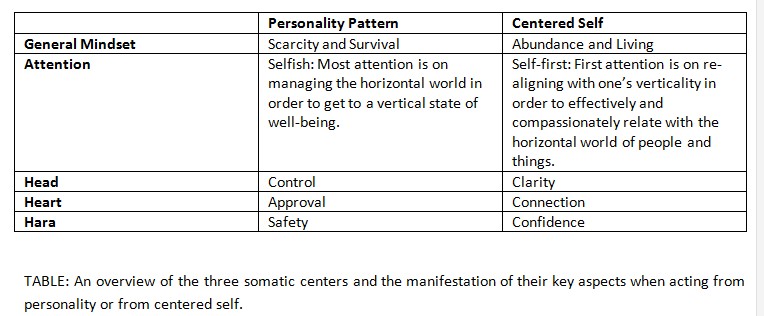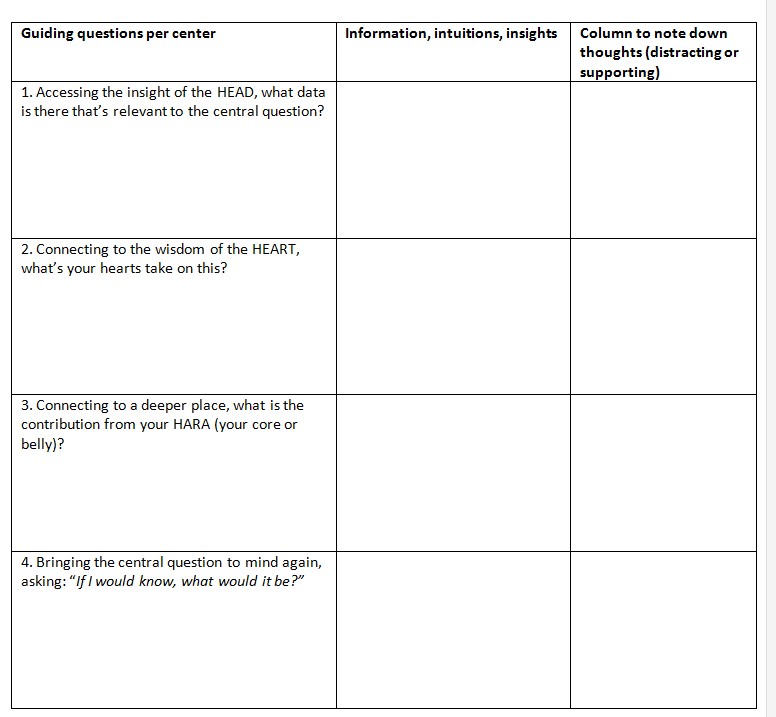Many thanks to our Dutch Integration Training Associate, Anouk Brack, for this article
Accessing the wisdom of head, heart and hara
Review of the Intuitive Intelligence framework and key practices
I was inspired by the work of Wendy Palmer to design The Intuitive Intelligence Framework. It consists of a map of different sources for “internal information,” such as from one’s instinct, intellect and intuition. It also includes practices that may facilitate one’s access to those sources. Having a well-developed intuitive intelligence means to be able to connect to, and generate and evaluate information from multiple sources of internal information. This approach works principally with three centres in the body, the head, heart and hara.
Framework Overview
The Intuitive Intelligence framework has been designed by Anouk Brack and is largely inspired by the work of Wendy Palmer. It consists of a map of different sources for “internal information,” such as from one’s instinct, intellect and intuition. It also includes practices that may facilitate one’s access to those sources. Having a well-developed intuitive intelligence means to be able to connect to, and generate and evaluate information from multiple sources of internal information. This approach works principally with three centers in the body, the head, heart and hara.
This document is not intended to be a full explanation of intuitive intelligence. Rather, it is intended to provide a brief overview of the core concepts, give practices for accessing several perspectives intuitively, and end with a worksheet to consult intuition on a specific issue. References for further reading are provided at the end.
Definition of intuitive intelligence
Intuitive intelligence is a capacity to access both rational and non-rational (both pre- and post-rational) sources of information. It includes instinctual information, mostly located in the hara (gut or belly) center, heart information, and center of the head information, as well as extra-somatic sources like accessing guidance or intuitively reading a system or situation. To access information about a situation or system we can use our three centers and pair them up with the 3 basic perspectives. One is intuitively looking at a system in our minds eye (head center, 3rd person perspective), relating with a system (heart center, 2nd person perspective), or sensing as the system (hara center, 1st person perspective).
Three somatic centers in intuitive intelligence
1. Head center
- Location: center of the head, above the ears just above eye-level
- Type of information: perception, data, insights, facts
- Quality: Clarity; overview, focus
2. Heart center
- Location: along vertical axis of the body, at heart level and just above, just in front of spine
- Type of information: feeling, longing
- Quality: Connection to self and other, compassion
3. Hara center
- Location: along vertical axis of the body, three fingers below navel, just in front of spine, physical center of gravity
- Type of information: sensing, sensations
- Quality: Confidence; life-force, strength, safety, instinct, gut-feeling
Access intuition with a shift to centered state
In order to prepare to access intuition it is recommended to engage in the four part centering practice that is summarized below1. When operating from the centered self, one is aware of being aware, with an upright posture and the three centers are aligned, there is a felt connection to the field of presence around the body. This is also called operating without effort from a flow state or being in the “zone”.
Extra-somatic sources of information
Consulting the three centers in the body usually gives sufficient information. In addition it is possible to consciously shift to sources of information beyond the body. Many people experience a sense of intuitive guidance from the space around their head, for instance a soft voice coming from the space behind the head on the right side. Also people can have a sense of guidance from a “higher” or “future” self, coming from the space above the head, about two hand lengths above the top of the head along the extended central vertical axis and a little bit more to the front. It is even possible to access intuitive information from the earth, from an organization, or to invoke the wisdom of specific inspiring archetypes. For instance, ask “What would the Dalai Lama do in this situation?” and then receive an answer in words, sensations, or images.
Role of the analytical mind
The question that comes after that is not “Is that really what the Dalai Lama would have done?” It is not possible to know that for sure. The use of the rational mind in that way is a waste of time. The point is that human beings have an extraordinary capacity to access multiple perspectives of different, deeper and higher wisdom. Accessing them often improves the quality of our response, helping us to be and behave more wisely and compassionately.
Most people experience the voice of the analytical, critical mind on the left and front in their head. Its role is doing what it does well: analyze and compare the gathered information from the different centers and help one to choose. Often it is not even necessary to engage the analytical mind. The actual choice is made subconsciously after multiple perspectives have been surfaced and have been held in conscious awareness while holding the intention for them to be integrated into one decision.
“Knowledge has three degrees—opinion, science, illumination. The means or instrument of the first is sense; of the second, dialectic; of the third, intuition.” – Plotinus
Practice Overview
Warm-up exercise: Questions to access and enliven the three centers
Hara:
What are you passionate about?
What arouses your life-force and creativity?
Heart:
What do you love? Care for?
What touches you deeply?
What are you longing for?
Head:
What excites you intellectually?
What fascinates you?
What kind of things do you find yourself explaining to others with lots of conviction?
You can sit with these questions, journal on them, or dialogue with someone. Take these questions as a starting point and let intuition take over from there. Practice not thinking about the next question while the response is being given. Allow for two to three seconds of silence to tune into the next question or response in service of deepening the conversation.
Accessing perspectives of three body centers
This is a practice to access intuitive information about a theme or question.
Step 1: Center
Step 2: State the question
Step 3: Inquire
Step 4: Reflect and / or Analyze
Optional steps:
Step 5: Negotiate
Step 6: Decide
Step 1: Center yourself using the four part centering process:
1 Posture: Align yourself vertically. Uplift to a relaxed, dignified posture and align your head, heart, and hara centers.
2 Breath: Breathe in up the spine, lengthen the neck, out the top of your head and breathe out down the front spiraling into the earth. Repeat three times for deeper presence and relaxation.
3 Field: Become aware of the field around you by realizing that there is heat coming off your body. What would it be like if it was equal and even back and front, equal and even on the left side and the right side? What would it be like if the upwards (centrifugal force) above your head was equal to the gravitational pull below?
4 Quality: Ask your body: What would it be like if there was a little bit more ease* in my body right now? (*or fill in another quality you want, such as precision, kindness, compassion, uplifted, blazing)
Step 2: State the question you are working with clearly. Some examples of questions that can work well: What intuitive information is there to help me make the most fitting decision on whether to move to another house? What deeper patterns are at play that support and obstruct the manifestation of an intimate relationship? What is the most suitable next step in my career?
Note: some examples of questions that don’t work so well: Should I do this? How can I get him to marry me? Why won’t I ever catch a promotion?
Step 3: Inquire into the 3 centers. Have a notebook and pen ready to make some notes during or after the process. Often people find closing their eyes works better. Also putting a hand on the center you are accessing can improve connection and focus. If the mind is very active with distracting or undermining thoughts, it may work to write those thoughts down in a separate column and leave them until later. Don’t fight them. Accept and re-focus yourself. If the thought: “nothing is happening” is quite loud, ask “If I did know, what would it be?”
è Use the worksheet below to organize your findings if you like.
Step 4: Reflect and / or Analyze. Take notes or draw what you saw and review all of it. Depending on your mood and preferred style, choose mostly reflecting, mostly analyzing, or a combination of both.
After relating with your findings for some time, ask yourself the original question again and pay attention to the answer(s) in the form of thoughts, images, sounds, feelings, sensations.
Optional: Steps 5 and 6 only apply in a decision making process.
Step 5: Negotiate with your centers like you would negotiate between different stakeholders of a project. Find out the underlying needs that are informing the standpoints and see if you can reach a win-win-win agreement. You can do this by journaling, dialoguing with a facilitator, or solely having an inner conversation (which is more difficult).
NOTE: Common negotiation rules also apply to inner negotiations. You will probably do business with this stakeholder again. So, don’t lie. Don’t promise things you don’t mean. Doing so is bad for your self-trust, inner integrity and cooperation between instinct, intellect and intuition. You might regret it later as many people are quite experienced in manipulating themselves when they least expect it.
Step 6: Decide. After going through all the steps, state the central question again. Is it still a workable question? If not, adjust it slightly. If so, read it (aloud if you like) and ask yourself: “If I knew, what would I do? “
If you like, do a final check using the Traffic Light visualization:
State the proposed decision and visualize a big traffic light in front of your mind’s eye. The top light corresponds with the HEAD center. The middle light corresponds with the HEART center. The bottom light corresponds with the HARA center. They can all have any of these three colors: Green = “yes/agree/support it fully”, Orange = “could be better/ don’t support it fully, yet” or Red = “No/don’t agree/don’t support it”.
Summary
This Einstein quote demonstrates beautifully the role the intellect and intuition can play in us:
“The intuitive mind is a sacred gift and the rational mind is a faithful servant. We have created a society that honours the servant and has forgotten the gift.”
Intuitive intelligence consists of the ability to access and integrate several sources of somatic and extra-somatic perspectives. It can be accessed and deepened through centering, mindfulness, and inquiring. Being intuitively intelligent means to practice to perceive, trust and act on intuition.
In the words of Buckminster Fuller:
“I call intuition cosmic fishing. You feel a nibble, then you’ve got to hook the fish.”
References and recommended resources
1 See for a more extended explanation of the centering process the Integral Sustainability Center Resource Tool No. 16 on Cultivating Leadership Embodiment.
- Wendy Palmer (1994). The Intuitive Body. Discovering the Wisdom of Conscious Embodiment and Aikido: Blue snake books; Berkeley, California, USA. (3rd edition published in 2008). She also wrote “The Practice of Freedom” and is in the process of writing “Wisdom to go” about Leadership Embodiment.
- Books and video material by Caroline Myss on intuition, working with your soul and piercing self-deceptions. See http://www.myss.com/
- Connect to Anouk@experienceintegral.org for more resources (articles, websites, and video) on Intuitive Intelligence, Leadership Embodiment and Integral Leadership. Anouk is available for coaching and training, both online and in-company.
Worksheet Accessing Intuitive Intelligence
Date:
Central question:
NOTES: Note that the 3 centers usually have a different way of communicating with you. Become familiar with their “language”, tone and vibe.


Penelope Parker
Thank you for sharing this. I needed some direction right now.
warkmalsh
you’re welcome